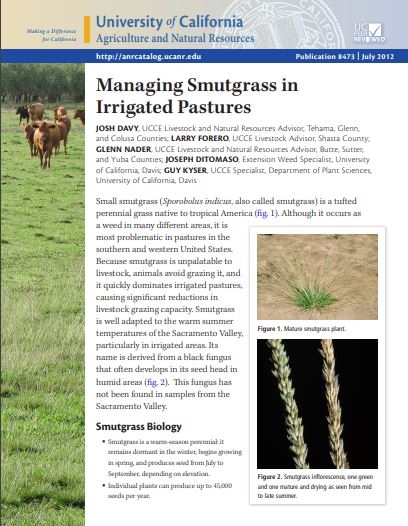
Smutgrass, in my experience, is a complicated, opportunistic weed, by which I mean there neither seems to be any single factor that contributes to its spread, nor any single management technique that leads to its eradication. Smutgrass seeds require bare ground, sunlight, and warm temperatures (68°F to 95°F) to germinate. Management practices (like pasture harrowing), or pests (like gophers) that lead to bare ground may provide a toehold for smutgrass establishment.
We have grazing exclosures established on several irrigated pastures on the eastern edge of the Sacramento Valley. The grazed portions of these pastures have significant smutgrass populations; the exclosures, where the forage grows all season without being removed, have little or none. To me, this suggests that getting the grazing right on our pastures may be part of the answer. If we can graze our pastures to 4-6" of stubble height, and then allow sufficient time for the desirable forage plants to regrow before we graze again, perhaps we can allow these "good" plants to outcompete smutgrass. On paper, this sounds easy; out in the pasture, it requires us to vary our graze periods and (more importantly) rest periods based on the growth rate of the pasture. Our rest period in June might be 25 days; in August it might be 40 days! Not every operation is set up to accommodate this variability.
We have noticed that dry ewes are more likely to graze smutgrass than lambs, particularly early in the season. Other producers have observed that goats will graze smutgrass. Davy et al. suggests that this may be related protein levels and digestibility. Clipping (or grazing) can maintain smutgrass in a more vegetative state, increasing palatability and nutritional value.
But even where we get the rest periods and graze periods right for the plants we want, we may still have smutgrass. Irrigation inefficiencies may favor smutgrass in some cases. Josh Davy and Betsy Karle found that smutgrass was significantly decreases on a pasture where irrigation was changed from a 14-day rotation to a 7-day rotation (with corresponding increases in more desirable grasses). I've noticed on the pastures that we irrigate for sheep that we seem to have more smutgrass in areas where shallower soils or lower water pressure results in less than optimal irrigation (in other words, we can't get enough water on these sites to maintain sufficient soil moisture in our 12-day irrigation rotation). And since our system is designed to run on 24-hour sets and 12-day rotations, we don't have a great deal of flexibility when in comes to addressing our smutgrass problem by adjusting our irrigation schedule.
Some producers in our region regularly clip their pastures to avoid eye problems and keep forage in a more vegetative condition. Research shows that repeated mowing can decrease the diameter of individual plants but increase the density of the stand. Mowing may also spread seed. On the other hand, mowing may maintain the nutritional quality of smutgrass further into the summer (which may improve its palatability for livestock).
Finally, glyphosate (RoundUp) may be a viable control option. A rotary wiper allows the operator to adjust the height of the wiper drum above the desirable pasture plants and "wipe" the herbicide directly on the smutgrass plants. This application should occur shortly after grazing (so that the desirable plants are lower than the smutgrass). According to Davy et al., "glyphosate should be applied after flowering when the plants are translocating sugars back to the roots or below-ground reproductive structures (generally late summer and early fall). Managing Smutgrass on Irrigated Pastures contains a helpful guide to using glyphosate with a rotary wiper. The Tahoe Cattlemen's Association has a wiper that is available for rent through Far West Rents and Ready Mix in Lincoln. If you'd like help learning to use the wiper, contact me at (530) 889-7385 or at dmacon@ucanr.edu.
Weeds are often a symptom of a management problem, rather than the actual "disease" - if we don't address the underlying issue (in the case of smutgrass this may be grazing management, irrigation management, or other factors), the problem is likely to reoccur. And with a weed like smutgrass that seems to be so opportunistic, eradication may be especially difficult. Controlling it (rather than eradicating it) maybe the most cost-effective option.